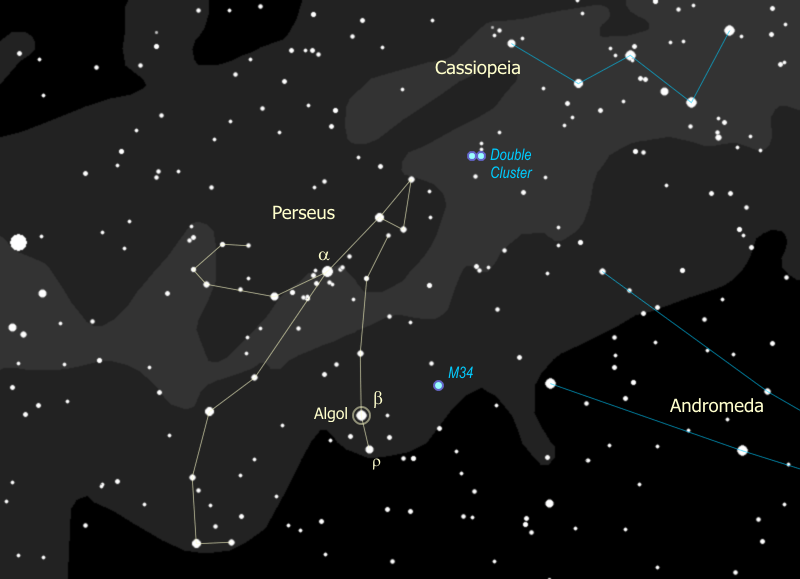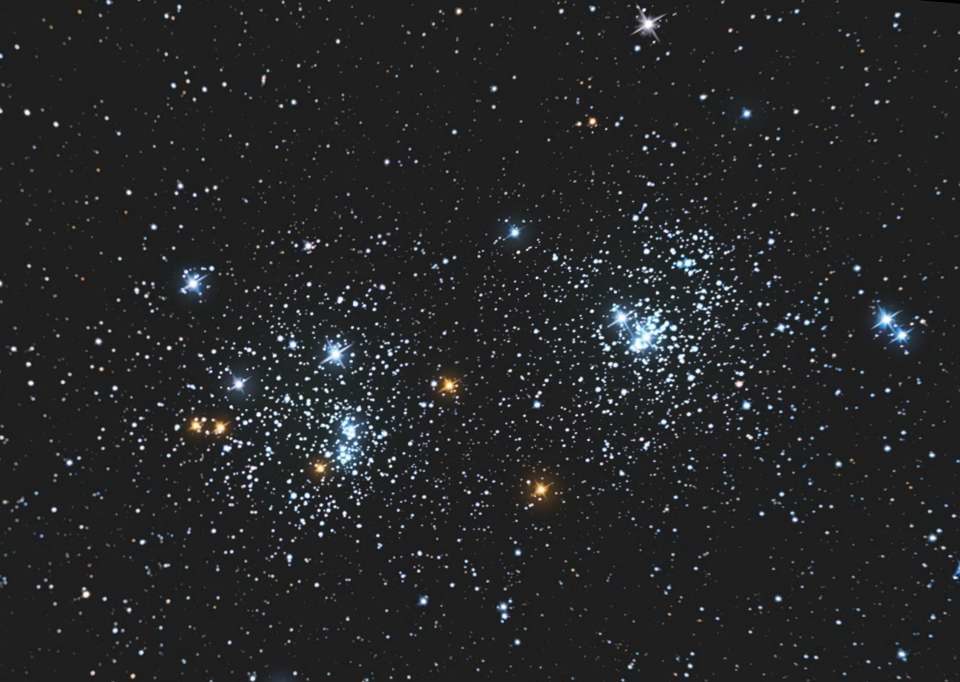Stargazing

|
Perseus the Hero |

|
Ah, here he comes, the guy we've all been waiting for, the hero of our story,
the one, the only -- Perseus!!
- You can find Perseus at Andromeda's feet, and just off the squashed side
of Cassiopeia's "W". The triangle that forms his head, though of modest
brightness, is an easy feature to recognize, then the rest of the figure,
which is pretty bright, is easy to follow from there. {Trace out Perseus}.
His right arm is holding his shield, and in his left hand he has the head
of Medusa the Gorgon. Being a man of action, he comes directly from his
triumphant victory over Medusa and stumbles upon Andromeda, soon to be in
the clutches of Cetus the Seamonster.

- The eye of Medusa is well-represented by the star Algol {point out Algol}.
Since ancient times Algol has been called the "Demon Star", and in fact the
name means "head of the demon". Why? Because this star winks at you.
Since stars aren't supposed to do that, it kind of gave people the willies
long ago, and they figured it had to be evil or posessed or in some other
way just wrong. Normally Algol is nearly as bright as
&alpha Persei {point out &alpha},
almost exactly as bright as γ Andromedae. Sure
enough, just about every 3 days Algol drops in brightness to that of
ρ Persei {point out ρ}.
It stays like that for a few hours then goes back to being as bright as
α. Any guesses why something like this might
happen?
Algol is actually a binary star, and the orbit of the two stars is right in line with us, so each time one star passes in front of the other, the second one is blocked and we see only half the light. This is called an "eclipsing binary". This is not the same as a Cepheid variable, where the star itself is changing. So what do you think -- is Algol in eclipse right now? We will check on it again when we get the chance and see if we can spot the change.
You might remember Medusa, she was a Gorgon, a monster with snakes for hair and so ridiculously ugly that anyone who looked at her would turn to stone. So how do you suppose Perseus saved Andromeda? That's right, he showed Medusa's head to Cetus, who promptly turned to stone and the princess was saved. Lucky he just happened to have that head on him, not usually something you carry around.
- If it seems to you that there are an awful lot of stars around
α Persei that's because there are... that is a
true glactic cluster of stars, all formed together, and they look spectacular
in binoculars. You can spot another cluster in Perseus half way between
Algol and γ Andromedae -- an easy target for
binoculars and with a really dark sky, one you should be able to spot just
by looking. This is M34, about 1500 light years away and very similar in
nature to the Pleiades or M36 in Auriga, although it's a little older than
they are, at about 100 million years.
- But the best cluster in Perseus is really two clusters, the Double
Cluster halfway between Perseus and Cassiopeia. You can find it easily
in the binoculars, and this is definitely worth getting in the telescope.
The one closer to Cassiopeia called "h Persei" and is "only" about 6 million
years old. The one closer to Perseus is called "χ
(chi) Persei" and is 12 million years old. How can you tell that
χ Persei is older? If you look at it carefully
in the telescope you might be able to spot 3 red giants in
χ Persei, whereas h Persei has no stars old
enough to have evolved yet into red giants.
Double Cluster with χ Persei to the left and h Persei to the right 
 |
 |
 |
| Back to the Andromeda | Winter Index | On to The Bears |
Questions
Your questions and comments regarding the Stargazing section are welcome.
You can e-mail the author, Randy Culp for inquiries,
suggestions, new ideas or just to chat.
Updated 18 July 2023
